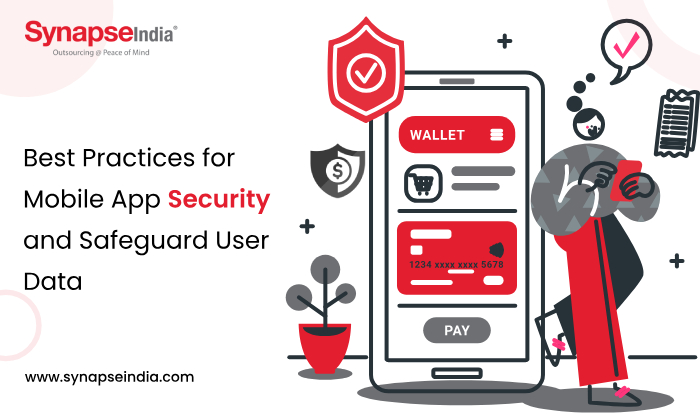 18 Mar 2024
18 Mar 2024“Implementing security practices ensures that user data remains protected from potential threats and breaches. Encryption, input validation, XSS, and multi-factor authentication are some of the factors that add an extra layer of protection.”

Mobile app security is a crucial aspect of the process of mobile app development. It involves safeguarding user data and threatening cyberattacks. It is important to prioritize the security of mobile applications, which gives it a growing reliance on various duties. In this blog, we will explore a few practices for mobile app security that help to safeguard user data. Mobile app security is the practice of safeguarding mobile applications from vulnerabilities and attacks. The mobile app security checklist includes a variety of techniques that protect the user data and applications too. From coding to frequent updates, Mobile app security best practices security aim to close gaps that hackers could exploit.

As we have seen number of mobile applications continue to evolve, and their risk also evolves related to it. Related to these threats, mobile app security has evolved as a great help that safeguards mobile applications from any potential threats. Understanding Mobile app security best practices is important for developers and organizations to protect the data of their users.
Some common issues affecting mobile apps can vary depending on various factors such as platform, device, network, and user behavior. Some of the most prevalent issues include:
Mobile app security checklists behave and sometimes provide slow loading times, lags, crashes, and freezes. This significantly impacts the user experience and leads to frustration for the user.
Those applications may not perform properly across different devices, operating systems, or screen sizes, automatically resulting in layout distortion or functionality issues.
Sometimes mobile applications can be vulnerable to various security threats. These threats include data breaches, malware attacks, or unauthorized access, which can cause risks to user privacy and sensitive information.
Few applications that consume excessive battery power or run in the background can drain device batteries quickly, leading to poor battery life and user dissatisfaction.
Poor network coverage or unreliable internet connections can disrupt app functionality, causing features like real-time updates or online transactions to fail.
To address these common issues, a proactive approach and measures are required. Using testing, continuous monitoring, timely updates, and responsive customer support ensures a seamless and satisfying user experience and also helps applications perform better.

Implementing the best security features is important to safeguard mobile apps and protect user data from various threats using Mobile app security best practices. Here are some best practices in the Mobile app security checklist:
Using the feature of encryption algorithms helps to protect sensitive data. This data is further used as stored data on the device which will be transmitted over the network. Data encryption helps the users to ensure even if attackers gain unauthorized access to the data, they won't be able to get it it without the encryption key.
Implementing secure authentication helps the user to verify the identity of users before granting access to the app. These security features like biometric authentication, multi-factor authentication, or OAuth for secure third-party authentication and help the user’s data to be safeguarded.
APIs are some vulnerable points in mobile apps, which can easily targeted to gain access to sensitive data. It is important to safeguard the APIs that are secured against common threats such as injection attacks (e.g., SQL injection), broken authentication, or improper access controls.
To make it more difficult for attackers to reverse engineer and comprehend the inner workings of the mobile application. By hiding the logic and flow of the code, obfuscation makes it more difficult for adversaries to obtain private data or control the behavior of the application.
To safeguard the sensitive data which is stored locally on the device is used to secure storage mechanisms provided by the platform. These platforms vary from Android Keystore or iOS Keychain. Additionally, avoid storing sensitive information in plaintext and utilize encryption to protect data stored on the device.
The above best practices safeguard mobile app security and help developers significantly reduce the risk of security breaches and ensure that their mobile apps provide a secure and trustworthy user experience.
It is important to prioritize the security of mobile apps to safeguard user data and maintain trust. By implementing the best practices such as data encryption, secure authentication, and regular updates, developers can lessen the risk of security breaches and protect sensitive information from unauthorized access. Additionally, adding secure coding practices, conducting comprehensive testing, and staying vigilant against emerging threats are considered important steps in ensuring the security and integrity of the Mobile app security best practices security checklist. Likewise, we have mentioned the following guidelines and continuously evolving security measures, so developers can create mobile apps that provide a safe and secure user experience in the world of mobile application development.


 31 Jan 2023
31 Jan 2023
